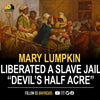Following global anti-racism protests sparked by the killing of George Floyd in the U.S., monuments connected to slavery and colonialism became the target of Black Lives Matter protesters across the world. In Iceland, which is not free of racism, thousands of people attended Black Lives Matter meetings organized by African Americans to show solidarity with the issue in the U.S. and explore matters of inequality in its own society. While countries joined calls to remove statues of colonial-era figures from public spaces, in Iceland, Independence Party deputy MP Vilhjálmur Bjarnason proposed that his country erected one — a statue that would celebrate the life and legacy of Hans Jonatan, believed to be the first Black man to settle in Iceland.
Before achieving celebrity status in Iceland, Hans Jonatan (he had no surname) was a slave in Denmark. He fought in a war, lost a famous case on slavery, and escaped by fleeing to Iceland. His story was largely forgotten until recently when a major genetic study identified some 780 living descendants of him.
Born into slavery in 1784 on the Caribbean island of St. Croix, then under Danish colonial rule, Hans Jonatan’s mother was Emilía Regína, an enslaved African woman on a sugar plantation owned by a Danish-German family named Schimmelman. Hans Jonatan’s father is believed to be of European heritage.
“[Hans] lived as a house slave somewhat protected from the rough field sites, the dissent and rebellions in the fields and somewhat exposed to the nice sides of aristocratic life,” Gísli Pálsson, a professor of anthropology at the University of Iceland, said in an interview in 2019.
At age seven, the Schimmelmans took Hans Jónatan to Denmark, where he lived in Copenhagen for about ten years. While there, he began reading and engaging with the growing discourse in Copenhagen about colonies and plantations and freedom and slavery, according to Pálsson, who wrote a biography about Hans Jónatan called The Man Who Stole Himself.
Pálsson said Hans Jonatan’s growing desire for freedom was one of the reasons he enlisted in the Danish navy in 1801. He probably thought that showing his allegiance to the Danes might make him free. But after surviving the war – one of the major battles in Denmark’s history – he came back still a slave. His superior officers, who admired his bravery, later advocated on his behalf to Denmark’s crown prince and de facto ruler, the future King Frederik VI. The crown prince wrote in a letter that Hans Jonatan “is considered free and enjoys rights.”
But the Schimmelmans argued that Hans Jonatan was their property and they could sell him back to St Croix. Hans Jonatan went to court to assert his freedom, in what would become a famous case at the time. Unfortunately, he was not able to produce the letter from Prince Frederik and in 1802, the court dismissed his claim. He was subsequently ordered to return to the Schimmelmanns, who were ready to sell him in St. Croix.
But Hans Jonatan fled, sailed to Iceland, and settled in the small village of Djupivogur. Around 1802 when he arrived in the remote Icelandic fishing village, locals warmly welcomed him. “He lands before racism arrives from Europe,” Pálsson said. “Before that, you had friction of course between people and groups, but not necessarily a hint at something in their genes, or the colour, or the character.”
Hans Jonatan lived in Djúpivogur, first as the store keep in the trading post, and then later as a peasant, according to one account. He married a local woman, had children, and lived as a free man until his death in 1827 after suffering a stroke.
It would take years before authorities in Denmark were able to find out where Hans Jonatan had escaped to. In the early 2000s when they found out, the descendants of Hans Jonathan in Iceland were also exploring their roots. Researchers who had the idea to re-create Hans Jonatan’s genome had started work during that period. At the end of the day, their study was able to reconstruct 38 percent of Hans’ maternal genome in absence of any physical remains. They traced it back to West Africa, and researchers now say that Hans Jonatan’s mother may have come from Benin, Nigeria or Cameroon.
What is worrying is the fact that Hans Jonatan is still considered property. Kirsten Pflomm, a fifth-generation descendant of Hans Jonatan, in 2018, petitioned then Danish Prime Minister Lars Lokke Rasmussen to declare Hans Jonatan, posthumously, a free man. But the prime minister replied in a letter back to her that he “cannot reverse time or the verdict of the past, no matter how incomprehensible it may seem.”
Denmark has however been taking steps recently to address its colonial past. In 2018, it unveiled its first statue of a powerful Black woman in its capital Copenhagen. The 23-foot statue of the Black slave rebellion leader, Mary Thomas, was created by Danish artist Jeannette Ehlers and Virgin Island native La Vaughn Belle. Mary Thomas, otherwise known as “Rebel Queen”, was a Caribbean woman who led a fierce 19th-century revolt against Danish colonial rule.
A statue to Hans Jonatan would not only be in recognition of his character, but would also honor his descendants and other enslaved people who fought for justice, said Pálsson. “He has a thousand descendants and their story is remarkable. Many of those in the second and third generation had to struggle with adversity. A monument would also honour these people and speak to the present moment that we are living in.”








